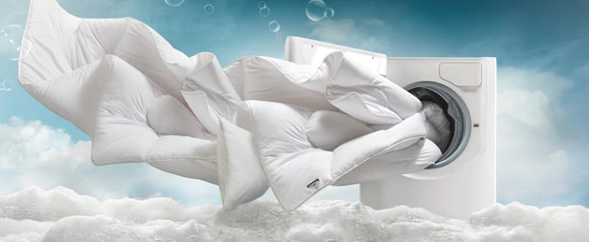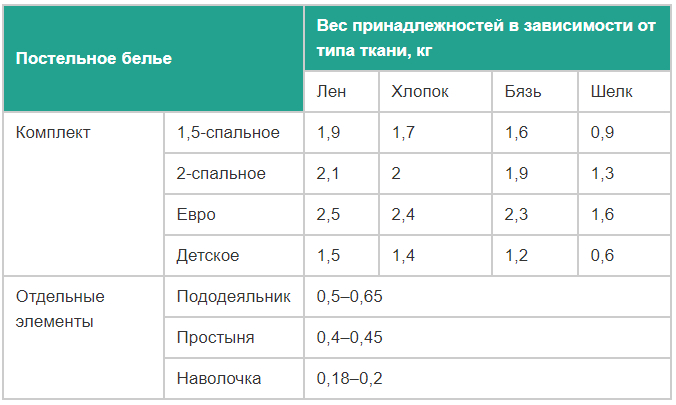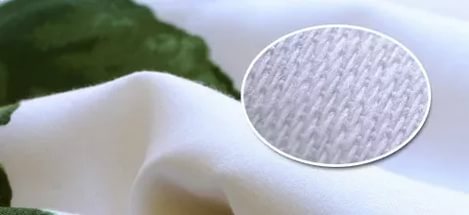It would seem that: I threw the dirty set into the washing machine, set the normal cycle, added the powder - and that’s it, the chores are over. But in reality it is not so simple. Bed linen also varies. Let's learn how to wash it correctly, with the least loss, and try to keep its appearance worthy.
Basic principles of washing
The most important a parameter that affects all manipulations with linen is its material. Modern sets are often made from fabric with a cotton base, but with a wide variety of admixtures. In addition, it is of great importance thread quality, production, sewing.
Today on sale are bed linen from:
- silks;
- percale;
- satin;
- calico;
- poplin;
- flax;
- viscose;
- polycotton;
- microfiber;
- terry;
- bamboo;
- flannel;
- calico.
If the former are distinguished by increased durability parameters and quality, then the latter are cheap and economical, but quickly become unusable.
Each set must have insert or label with recommended regimens. Must be registered temperature for hand and machine washing, requirements for ironing, tumble drying, bleaching, all the prohibitions and permissive nuances. When purchasing a kit, be sure to check for the presence of such a label.
The drum should be loaded to no more than 2/3 of its volume.

How much does a set of laundry weigh?
These indicators are not important. With drum loading limits of 5 kg, it is allowed to load 2.5–3 kg of laundry, so an error of +/- 0.5 kg will not matter much. However, if you need to calculate the exact figure, you can use this table.

@protkan.com
The denser and cottonier the material, the heavier it is.. For example, a Euro set made of linen weighs 2.5 kg in dry condition, and one made of silk - 1.6 kg. You can only load one linen set or two silk sets at a time. And polyester will be even lighter.
What to wash with?
Most types of bedding hold up well to standard advertised products.. Universal ones can be called “Eared Nanny”, “Stork”, “Tide”, “Ariel”, “Gloss”, “Persil”. Among the nuances it is worth noting the following:
- Bleach powder is great for washing white sets;
- for colored people, it is preferable to use a product with enzymes and stain-removing agents that prevent the brightness of colors from being washed out;
- For delicate silk fabrics, gels designed specifically for them are recommended.
They handle washing very well and at the same time maintain the color and structure of fabrics. phosphate-free powders.
New linen – do you need to wash it?
Undoubtedly. The new kit is absolutely not sterile, as most people think. It is treated with preservatives, since the final date for its sale is unknown.In addition, to create a marketable appearance, the linen is also coated with a special composition, so it must be eliminated before the first use.
How to wash without fading?
If you have doubts about the quality of the material, then you should choose gentle mode, minimum temperature and detergent for colored laundry. You can try hand washing.
Unfortunately, low-quality fabrics tend to “give up” their colors when wet. This is due to the fact that their manufacturer dyes the linen after production, while good materials are made from already dyed threads.
Of course, we cannot discount poor quality paint. You can understand that the product will “float” in two ways: squeeze the material in your hand (it will crunch) or run a damp cloth over the surface (it will leave a mark).

@thespruce.com
How to wash laundry?
Stains on bedding should be treated as soon as possible. As a rule, local soaking is carried out, and then completely washed. If the contamination is extensive, it is worth soaking the laundry in a saline solution overnight. Proportions: 1 tbsp. l. salt per 1 liter of cold water. This will “push out” the dirt, which can then be successfully washed in the machine.
If the stain doesn't come out the first time, it's worth trying. folk remedies. A solution of ammonia, lemon juice, peroxide, glycerin, and simple laundry soap will help. Aggressive store-bought chemicals are best used as a last resort.
Among industrial stain removers, we can recommend Sodasan, Lion Top Precare, Top Rescue Lion, Udalix, Meine Liebe, Luxus Professional.
From blood
Such spots are the most frequent “guests”. Here it is necessary to remember that hot water will be the worst solution to the problem. You must first wash off the blood under the tap, then soap it separately in a basin with laundry soap and soak the stained area of the laundry in cold water. After 30–60 minutes, put it in the machine and wash at 30°C on the usual cycle.
From brilliant green
Important rules: Do not use hydrogen peroxide, bleach or chlorine-containing products to remove such stains. You must first rinse the contaminated area under running water.
Regular gray works great laundry soap, vegetable oil, vinegar, alcohol. All cotton fabrics react correctly with manganese solution. Simply treat the stain, leave it for a while, and then wash it as usual.
From iodine
Cold milk – the best remedy for eliminating such stains on cotton fabric. But you need to react instantly. You need to soak the stain in it, and then wash it as usual. If traces remain, you can put the product in the sun for several hours.
Iodine can be removed from synthetics using alcohol or acetone. Using a small cotton swab dipped in the product, wipe the stain from the edges to the center until it begins to fade and disappears. Then wash at 30 degrees.
From yellowness
Such spots appear over time. To help eliminate them:
- Soda. Mix with ammonia (0.5 tbsp. soda, 2 tbsp. ammonia, 5 liters of water) and soak the fabric in the solution or cover the stain with soda, and after two minutes pour vinegar over it. Then wash as usual.
- Ammonia. Soak the product in a solution (1 tablespoon per 1 liter) of water for three hours, then wash it in powder.
- Hydrogen peroxide. Suitable for white linen. Take 1 bottle of product for 5 liters of water. Soak the item in the solution for 20 minutes. Wash as usual.
From an unpleasant odor
To prevent bed linen and towels from becoming soggy, it is necessary store them in a ventilated cabinet or with special moisture-absorbing substances placed on the shelves. Essential oils perfectly mask the odors of herbs in bags. The latter can be added when washing in the machine directly into the powder compartment. Table vinegar, baking soda, and fabric softener can also deal with unpleasant odors.

@verlo.com
Features of washing children's bedding
The baby crib set must be washed once every few days or more often as it gets dirty. It is recommended to use not chemicals, but home remedies. Laundry soap is best suited for washing, and “Eared Nanny” or “Stork” and other products marked “from the first days of life” are for the car.
It is strictly not recommended to put baby bedding in the drum together with adult linen.
The powder should not contain surfactants, phosphates, flavors, or chlorine components. As a rule, children's bedding is made of cotton, and it can be washed as usual at temperatures up to 60 degrees. And be sure to double rinse.

@home.bt.com
How to starch laundry?
Such bedding is considered highly hygienic, slightly crunchy and looks beautiful. You can starch the kit before rinsing. Proportions: for 20 liters of cold water 3-4 tbsp. l. starch.
How to do:
- boil 20 liters of water;
- add starch in a thin stream, stirring continuously;
- boil the solution for 5 minutes;
- cool to room temperature;
- remove washed laundry from the machine;
- dip it in prepared milk;
- wait 10–20 minutes;
- wring out the fabric, smooth it out so that there are no creases;
- hang to dry.
There should be no lumps in the starch solution. Such linen should be ironed under-dry to ensure that all creases and folds are removed.
Important! Only cotton fabrics can be subjected to this treatment - linen, satin, calico, chintz. Synthetics do not starch.
For a little starching, you can make starch water in a spray bottle and spray the bedding while ironing.
How often should I wash?
The kit must be changed at least once every two weeks in winter. In summer twice as often. In addition, it is recommended to wash pillowcases at least once every seven days. If a stain appears on your laundry, don’t hesitate to put it in the dirty basket. It is better to change baby bedding every few days.
Of course, during illness you need to wash your pillowcase, duvet cover and sheets much more often.


 0
0





